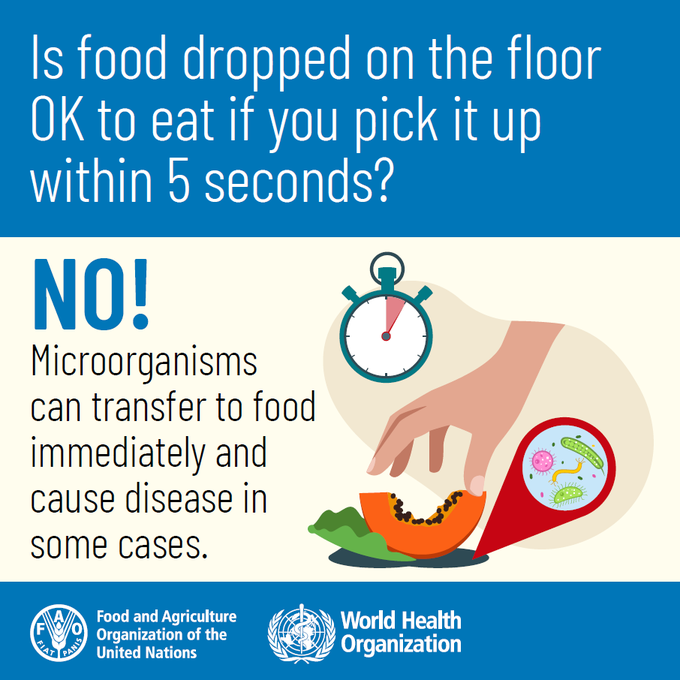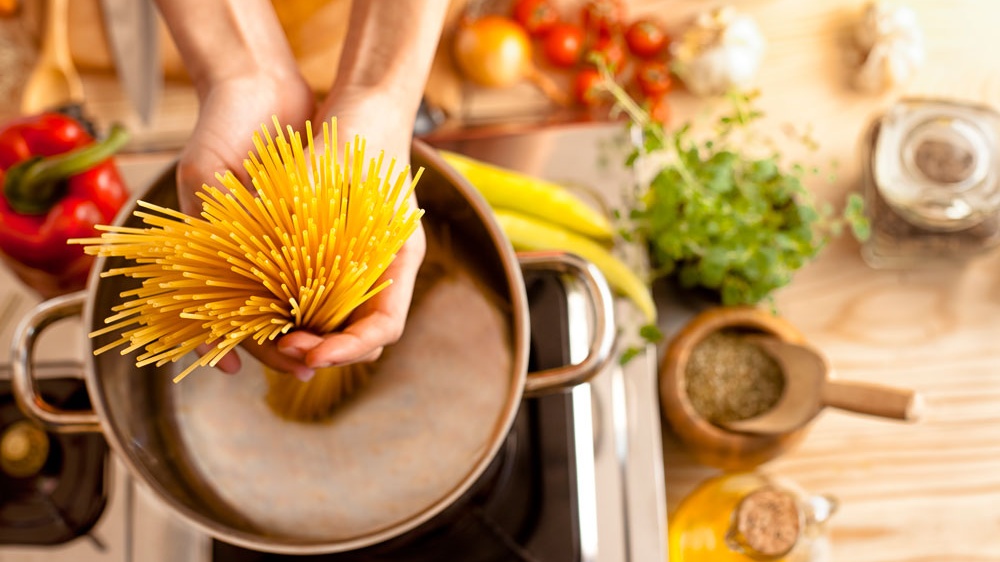Food on the floor

 Add to favorites
Add to favorites
My niece sent me a picture the other day of her 7 month-old baby Thalia eating in her high chair. Was all that mush food? Why was it spread all over the surface of the high chair? And what was that on the floor? The rest of her food? Perhaps there was more on the floor than on her high chair. And oh, is that the dog on the floor lapping up the food? And am I seeing Thalia throwing food down to the dog? Some of it landed on his back!
That brings me to the five second rule. She’s not far away from Cheerios or pieces of hot dog set on her tray. When my nieces were babies that’s what their mom fed them at breakfast and lunch. When they babies flipped that solid food on the floor it was picked up and put back on the high chair tray.
Is that a good idea? Is the five second rule a real thing? Here’s what the scientists have to say:

Much of the rest of this science is an excerpt from a Bon Appetit newsletter feature. Those folks know their food, so I’m confident they know the right food science folks too. I thought you’d find this interesting.
The rule’s “genesis is difficult to ascertain,” says Paul Dawson, PhD, a food scientist at Clemson University. In Did You Just Eat That, Dawson and his co-author, Brian Sheldon, PhD, wrote that an early iteration is sometimes attributed to Mongol ruler Genghis Khan. During his 13th-century reign, food that fell on the floor at one of the Khan’s elaborate banquets could stay there as long as he deemed fit; the delicacies were simply too good to ever go bad. Fast-forward to the 1960s, when Julia Child echoed the same sentiment on her cooking show, The French Chef. After dropping a potato pancake on the stovetop, she wasn’t fazed: “But you can always pick it up, and if you are alone in the kitchen, who is going to see?” Child told her audience.
These days scientists know a whole lot more about what might be lurking on our floors. Viruses, microorganisms, bacteria, and foodborne pathogens, like E. coli and salmonella, can all be found on everyday surfaces, says Donald Schaffner, PhD, a food science professor at Rutgers University. Some likely come from the air, while others are transmitted from surface-to-surface contact—via shoes, kids, or pets. Most of these won’t make us sick, he says, but some can: “If a foodborne pathogen from the floor were to be eaten, symptoms could include nausea, vomiting, and diarrhea.”
There’s no amount of time that would guarantee none of those bacteria or pathogens transfer from floor to food, says Schaffner. In a 2016 study, he found that the longer the test foods—watermelon, bread, buttered bread, and gummy candy—sat on the inoculated surfaces, the more bacteria they would pick up. But the amount of moisture in the food was a bigger factor in determining how intensely and how quickly foodborne occurred. When testing wetter foods like watermelon, “we almost always saw 100% of the bacteria transfer virtually instantaneously,” Schaffner says.
The cleanliness of the surface also affects how much bacteria a food might collect. “If a floor is free of any microorganisms, then nothing can transfer to the food,” Schaffner says. This kind of sterility requires fastidious cleaning. “A vacuum or broom will not remove or eliminate bacteria and viruses,” cautions Dawson. For that, “surfaces that are in contact with food require use of a sanitizer.” The type of material also makes a difference; Schaffner found that less cross-contamination occurred between foods that were placed on porous carpet versus those on tile or stainless steel.
Immediately washing your dropped ingredient with tap water will remove some of the bacteria they might have collected, Dawson says. But this only applies to certain foods—like uncooked fruits and vegetables, rather than eggplant parm or a piece of cake (which you probably don’t want to wash with tap water, right?). Not all foodborne pathogens are destroyed by cooking them either, Schaffner says . Though, “as long as the food is properly cooked and consumed promptly,” the risk of getting sick from food that briefly liaised with the floor is very low.
So, should you eat food off the floor? “I try not to tell people what to do,” says Schaffner. Dawson recommends discarding dropped food: “I don’t think it’s good practice to eat off the floor,” he says. Though the scientist admits he’s been known to ignore his own advice for “a cashew or two.”
Have I ever dropped food while I was cooking for a dinner party? I’m sure I have. Did I ever pick it up and put it in the pan to cook it and serve it? Nope. When I was a young adult, I worked in restaurants. I did a short stint cooking on the line. I was in charge of omelets, salads and sandwiches. Did I drop food on the floor there? Of course I did. In that environment you are moving so fast that when you crack open and egg and throw the shell toward the garbage bin it doesn’t always make it to the container. Those floors have raised mats on them for a reason. All the food you drop goes into the cracks in those mats. And it stays there til closing time when the right guy will come by and pick up the mat, scoop up all the food that hit the floor, throw it in the garbage and then sanitize the floor and the mat. That’s where I learned there is no five second rule; not even a one second rule. Just carry on and cook.
Cheers,

Nothing found.
Smash Burgers
ZSpecialties,Recipes,ZS-5 Ingredients or Less,ZReboot,Featured Posts
Smash burgers are all the rage. Step into a brew pub and you’ll likely find a smash burger on the food menu. These are NOT the huge, 8oz burgers we’ve been fed in the past. These are a thinner burger…
Nothing found.
Kitchen Hacks for Enjoying Lower Carb Pasta Meals
Enjoy your pasta; just don’t do it too often. Follow hints like this and you’re much less likely to gain weight.
Why To Eat Low Carb
Resolve to eat smart. Low-carb eating is not a trend. It is a smart solution to weight loss and weight management.





